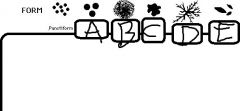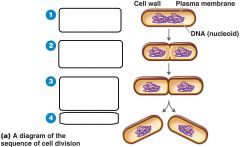![]()
![]()
![]()
Use LEFT and RIGHT arrow keys to navigate between flashcards;
Use UP and DOWN arrow keys to flip the card;
H to show hint;
A reads text to speech;
19 Cards in this Set
- Front
- Back

|
a. Circular b. Filamentous c. Irregular d. Rhizoid e. Spindle |
|

|
a. Flat b. Raised c. Convex d. Pulvinate e. Umbonate |
|

|
a. Entire b. Undulate c. Filamentous d. Lobate e. Curled |
|
|
Name 4 different methods of reproduction in Prokaryotes * by which method do Bacteria usually reproduce? |
1. Budding 2. Binary Fission 3. Fragment of Filaments 4. Conidiospores * Binary Fission |
|

|
1. Cell elongates and DNA replicates 2. Cell wall and plasma membrane start to constrict 3. Cross-wall forms, separating sets of DNA 4. Cells Separate |
|

|
a. DNA b. Partially formed Cross-Wall |
|
|
- Generation time is defined as __(a)__ - Generation time is affected by __(b)__ conditioned - For most bacteria, the Generation time is __(c)__ hours |
a. The time required for a cell to divide b. Environmental conditions c. 1-3 hours |
|
|
How many bacterial growth phases are there? |
4 |
|

|
1. Lag phase 2. Log phase 3. Stationary phase 4. Death phase |
|
|
What are the 2 main categories within the bacterial reqiurements for growth? |
1. Physical requirements 2. Chemical requirements |
|
|
a. What does physical requirements include? b. What do chemical requirements include? |
a. - Temperature - pH - Osmotic pressure b. - Carbon - Oxygen - Organic Growth Factor - Nitrogen, Sulfur + Phosphorous - Trace Chemicals |
|
|
pH: - Most bacteria grow between pH __(a)__ and __(b)__ - Molds and Yeast grow between pH __(c)__ and __(d)__ - Acidophiles grow in __(e)__ |
a. 6.5 b. 7.5 c. 5 d. 6 e. Acidic environments |
|
|
(Osmotic pressure) Which kinds of environments would cause Plasmolysis in a bacterial cell? |
- Hypertonic environments - An increase in Salt or Sugar |
|
|
a. Name 3 trace elements b. What are trace elements usually used as (in growth) |
a. - Iron - Copper - Zinc b. Used as Cofactors for enzymes |
|

|
a. Obligate Aerobes b. Facultative Anaerobes c. Obligate Anaerobes d. Aerotolerant Anaerobes e. Microaerophiles |
|

|
a. Only Aerobic growth (O2 required) b. - Both Aerobic + Anaerobic growth - But better growth in presence of O2 c. Only Anaerobic growth d. - Only Anaerobic growth - But growth continues in presence of O2 e. - Only Aerobic growth - Requires a low O2 concentration |
|
|
a. What are Organic Growth Factors? b. Give 4 examples of Organic Growth Factors |
a. Organic compounds gained from the environment b. - Pyrimidines - Purines - Amino Acids - Vitamins |
|
|
Biofilms: - Biofilms are Microbial __(a)__ - They form __(b)__ or __(c)__ - Share __(d)__ and are sheltered from __(e)__ |
a. Communities b. Slime c. Hydrogels d. Nutrients e. Harmful factors |
|
|
Biofilms: - Are __(a)__ times more resistant - Are involved in __(b)__% of human bacterial infections - Tend to form in __(c)__ and in __(d)__ |
a. 1000 times b. 7% c. Contact Lenses d. Dental Caries |

